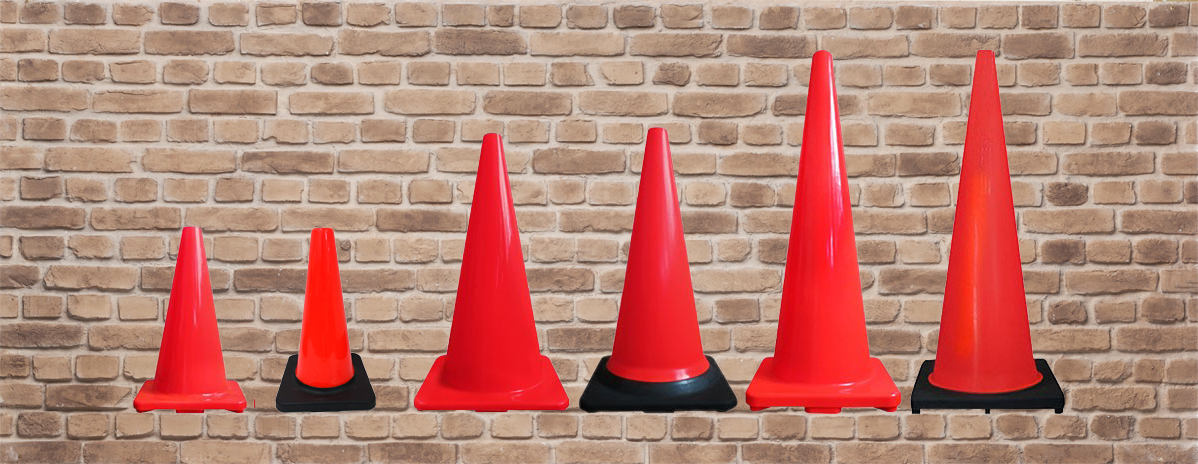How to choose a traffic cone?

What is traffic cone?
Traffic cones, also known as road cones, safety cones, or construction cones, are tall, cone-shaped markers. They are taken as temporary barrier, to temporarily control traffic or block off danger areas. As a visible barrier or marker that guides drivers and pedestrians around the area, they are commonly to been seen amid road construction, maintenance, road accidents and emergency situations.
Traffic cones are typically made of plastic (such as PVC or PE) or rubber, and they come in a variety of sizes and colors. They are lightweight, easy to move, stackable, and can be placed quickly. In addition, they are very affordable. All of these make traffic cones are the most favorite barrier equipment.
They are also often used in parking lots, warehouses, gathering events and various other places where temporary traffic control is needed. Small cones are often used for sports training and amusing games.
How do we choose a traffic cone?
When choosing a traffic cone, there are several factors to consider
Visibility: For purpose of traffic control and hazard alert, make sure you choose highly visible cones, it means the cone with bright color. Fluorescent orange color is the mostly common to use in the area of roadways, construction sites. Of course, other colors are available for different purposes and activities.
Size: Traffic cones come in a variety of sizes, from as small as 18 inches to as large as 42 inches or more. You choose an appropriate size with reference to purpose, location and regulation. Such as, 28 inches are generally used in crowded streets, 36inches are used on high speed roadways. 18inches are used in the garages driveways , sidewalks. Smaller 18 inches are used for sports.
Weight: Weight & Size always come to think together. If the environment is windy and traffic is busy, suggest to take a heavy cone. But when you need to move it frequently, easy transport is a matter.
Reflectivity: If the cones will be placed at night or in low-light environments, then choose cones with reflective tapes, or add warning lights to enhance visibility.
Durability: Cones are purposed to endure crash and over-run impact by vehicles, and mostly are located outdoors. It’s important to Look for cones made of durable and weather-resistant materials that can withstand heavy use and outdoor conditions. PVC is the most popular choice at the moment.
Brand/Manufacturer: Reliable Quality and service is worthy for not being cheap. Search good quality brand and manufacturer to avoid customer disasters from complaints and claims disasters.
Standard Compliance: There are strict regulations and standards in countries for cones used for traffic management. If you will use cones for traffic control on roads and highways, make sure to use cones that meet the standards set by your local transportation department. To this point, It's recommended to consult with local authority or professional before making a purchase.
What are differences for plastic cones and rubber cones?
The most choices of plastic material for cones are PVC (polyvinyl chloride) and PE (polyethylene). They are all made of plastic, and they have similar performances. PVC cones are generally more durable and impact-resistant than PE cones. Also PVC cones are less expensive than PE cones. PVC cones and PE cones are recyclable, but PE cones are often more easily recycled.
Rubber cones are made of rubber. In comparison to plastic cones, the advantages are more resistant to damage, more resistant to impact, and higher UV resistance, and the disadvantages are higher cost, heavier, less bright colors and harder to recycle.
If durability and stability are more important for you, rubber traffic cones may be a better choice. For point of balancing weights on performances, the cost, and environment friendly, the plastic cones are a tendency choice. Due to similar performances and footprints between PE and PVC, PVC has less cost advantage to get more preference.
After all, the decision should be based on your specific needs and requirements and the conditions in which the cones will be used. It's a good idea to consider all the factors, including cost, durability, stability, visibility and environmental impact before making a decision.
